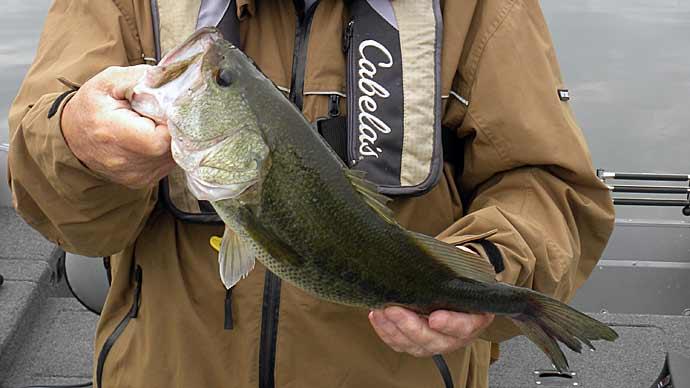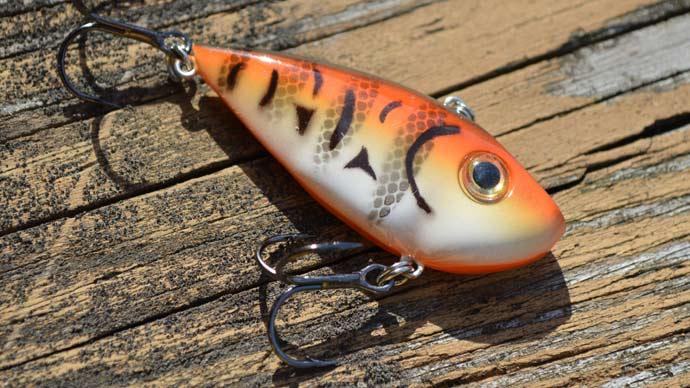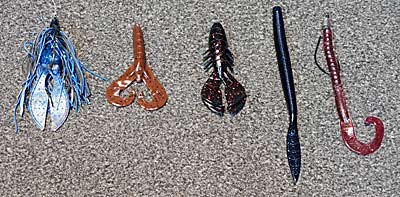
Summertime is the next biggest season you must deal with on the bass calendar. Of all the changes that you will encounter, Summer is the season that the bass will set up residence in an area and will hold for about 4 to 5 months. It’s one of the most stable seasonal changes you and the bass will face all year. What will make a bass change during the season is related more to food than anything else. Let’s cover 5 top summer baits you should have within arm's reach when you hit your favorite bass waters this summer.
Texas Rigs
In the past few years, I have fished a Texas rig more than I have a jig-n-pig. Day in and day out, a jig was always the first rod I would grab out of my rod locker to fish. Yes, I was successful at that, but in the last few years, I have caught more bass throwing a Texas-rigged worm than a jig simply because I’m one of the very few, I think, who is fishing a Texas rig today. A Texas rig has become the classic go-to that few fishermen fish anymore.
I was cleaning up my shed and pulled out a bin with many older plastics in it, and I came across a few bags of Toledo Tackle worms. These were the go-to worms 20 years ago but have fallen completely off everyone’s radar today, so I grabbed the few bags that I had left and put them back in the boat. The next time I was on the water, I grabbed my worm rod, rigged on a worm, and started to make a few casts. It did not take long before I got my first bite, and the rest of the day was catching a bunch of bass between 2 to 5lb—one of the best days I had had on the water in the last few years.
Now, you don’t need to fish worms from your past to be successful; many plastics companies are making an impact today. Missile Baits, Culprit, Berkley, and Bass Pro are all top plastics companies making top-selling baits. I have fallen into the Missile camp; they offered me all the bait shapes and actions I’m looking for from a plastics company, and I’ll add that my plastics fishing has gained a few more steps than before. Part of this has come from adding new line options like fluorocarbon and braid additions.
Another addition that has taken Texas rig fishing to a new level has been tungsten weights. Tungsten is smaller and transfers a better feel than lead, resulting in more bass over the side of your boat. I use tungsten to help me find better rock areas and figure out how they lay out. I use this same tactic to enhance not only my Texas rig fishing but also my jig fishing.
Another change that has solidified this is that I depend not only on worms as my plastic choice. I have been Texas rigging more baits than just worms. Stick Baits, craws, tubes, and creature baits now round out my Texas rig assortment.
Topwaters
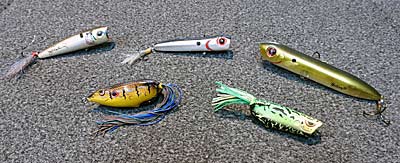
Topwaters have come of age in the last few years but have been in the background for many years. Yes, we would throw one on key occasions, but not with the regularity we do today. Much of this is due to the introduction of braided line, which has taken topwater fishing to a new level. You can make long casts and work your topwater bait with ease, enhancing the action of your bait and triggering more bites simultaneously.
One drawback with braid is that it’s limp and sits on top of the water. The best choice to combat your topwater getting tangled in the braid is to add a monofilament leader. Baits to stock in your summer arsenal are popping bait. Storm Chug Bug and Rebel Pop R are the top 2 that I carry. I will vary my retrieve speed and action to match the bite conditions I face that day. The next bait in your arsenal is a walking bait, and at the top of that list is a Heddon Spook. There are a few different baits in that family: a straight Spook, I also have a chug Spook, and a smaller size to cover my bases to throw a Spook for all types of bites. The last topwater category is a SPRO Bronzeye frog and popper. These die-hard summer staples must be in your collection when bass bury deep in the pads or hold on the edges of thick covers, looking for passing dinner that gets too close.
One key here is that you take the time to ensure that your hooks are sharp. Bass sometimes don’t get a clear shot at your bait, and they will swipe at your bait to try to stun it, resulting in them just getting one hook point into them. Sharp hooks often turn these into bass in the boat instead of bass lost at the side of the boat.
Adding a simple feather treble tail hook can distinguish between excellent and poor days. The feather's movement alone, many times, will get the bass to strike even when the bait is sitting still.
Jig-n-Pig
If you gave me a choice of only having one bait for the rest of my bass fishing days, I would have to choose a jig-n-pig to end my days with. I depended on it for many years, and I have seen the bass it catches, making it my top bait choice until I hand up my rod. A few of the biggest things that have changed jig fishing through the years are silicone skirts. Silicone skirts come in every baitfish pattern to swim in our waters, so it’s easier to imitate local bait in your waters than ever before. Carry an assortment of skirts as well to be able to match the forage in the water. If the bass is eating bluegills, match your skirt to that color. If the bass is keying in on craws, match your jig to your local craws to trigger strikes. This will put your bait in the favor of the bass looking for an easy meal.
Add rattles if you’re fishing in dirty water or weeds, but put them away if you’re fishing in clear water conditions. If the bite is on the slower side of the fishing spectrum on a particular day, a jig is a bait that I’ll pick up and start to fish with. The better you can match the forage with your jig, the better your odds of getting more bites are.
I will pick my trailer according to the time of the season I’m fishing, and I will also consider what I know about the forage in the waters that I’m fishing. This will set what trailer to use that day many times. Some anglers throw a pork trailer occasionally, but most of today's jig fishing is done with a plastic trailer. This selection gives you more choices to work with, but a part of me will still team my jig with a pork frog when conditions call for it. It is more of a nostalgic thing than the belief that pork is better than today's plastics. Plastics have kicked the door open, giving fishermen more options to pair on a jig than pork can offer. Where you stand will depend on what camp you want to be in. Myself, I embrace both sides and still use both to my advantage.
I will tell you I have more options for using plastics than pork, and I’ll use that as an advantage. Watercolor will also influence my bait choice. If the water is clear, I may lean towards pork, but if the water is stained or dirty, I will pick a plastic trailer as I can get more action and movement out of plastic than I can out of pork. This alone can be the difference between putting bass in the boat or not catching bass all day. The bass must be able to find the bait before they can bite it.
Add the line choices with braid and fluorocarbon in today’s mix, and your jig fishing will rise to the top of the pack when given a decent chance.
Ned Baits
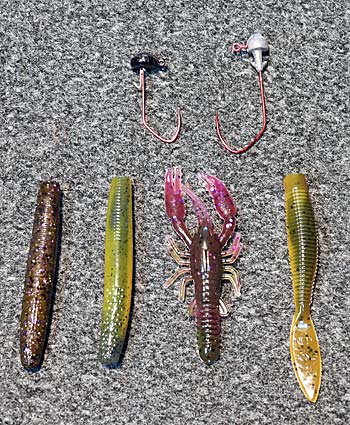
With all the pressure our bass fisheries are getting today, you must throw a finesse bait or two into your mix when on the water. The most popular finesse choice going today is a Ned rig. Most of the time, a Ned is fished on a spinning rod (7ft preferred) matched with a size 200 or 300 spinning reel that is spooled with a 10lb to 15lb braid line that is teamed with an 8lb to 10lb fluorocarbon leader. Now, you can vary this setup to your liking.
A few notes: when it comes to bait choices, pay attention because you do have some options. The most prominent note here is regular plastics vs elastic plastics. Regular plastics often have some salt mixed into them that will cause the bait to sink. How fast it sinks will depend on how much salt is in the mix. Elastic plastics have a floating quality; they will fall slower and tend to float tail up on the bottom, depending on your jig head choice. Use this when picking and rigging ned baits and jig heads for your daily mix. Use these critical benefits to your advantage.
If the bite is on, go with regular plastics Ned’s and cover water, but I’ll also have an elastic version rigged on a stand-up jig head and ready to go as a backup. I will always give this bait a few casts before I move on to my next stop. I will also reverse this if I use the elastic bait as my primary bait; I will make a few casts with the regular Ned before I move on. By offering the bass two different looks and actions, you can trigger more bites during your day than giving them one option.
Crankbaits
Crankbaits are one of the quickest ways to cover water and look for signs of bass. In my assortment of crankbaits, I carry a few square bills, mid-depth, and deepwater crankbaits to cover all the needed depth ranges from the start of the summer months to the early fall season. Stock a few rattle models and silent (non-rattle) crankbaits in your crankbait box. I will often match my crankbait to the water conditions I’m fishing.
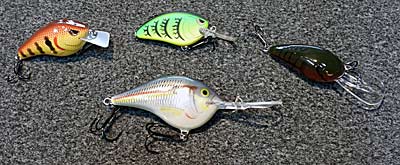
If I’m faced with fishing in a clear water lake, I will choose a crankbait that doesn’t have a rattle. The bass may often feed more by sight in these situations, and the sound of the bait as it swims through the water is enough to get the bass' attention to help them find the bait and strike. When fishing in stained or dirty water conditions, your success will be better using bait with a built-in rattle. Now, rattles come in a few sounds to arm yourself. Buy a couple that have a different sound. I have had many situations where the bass will prefer one over the other, and the best way to see what is wanted that day on the water is to give your baits some water time and let the bass tell you the preferred sound.
It's the same situation regarding crankbait patterns: stock baitfish and craw colors to match the forage in your waters. I will also throw in a few bizarre loud colors, as I call them, to make your bait stand out and help get it found. These work best in both dirty and clear water conditions.
One key to crankbait fishing is line size. Match your line size to the conditions you’re fishing in. I often fish a deep-diving bait on a 10lb to 12lb line. I prefer Sunline Crank FC as my line choice. This is a fluorocarbon line that has a little stretch built into the mix in case the bass makes a last-minute turn at the boat.
I will use Crank FC in the 12lb—14lb range for shallow and mid-depth. In shallow water, you’ll have to deal with weeds and cover, so I will beef up my line choice to fit my fishing conditions. I always use a snap at the end of my line for faster bait changes, and I feel it gives my bait better and more action.
These summer go-to’s set you on a path to catching more bass this year. These options are flexible; nothing is set in stone. I suggest these to give you a starting basis and hope you will expand from there to better dial in what you’re faced with on your waters. Have A Bass Filled Summer.


